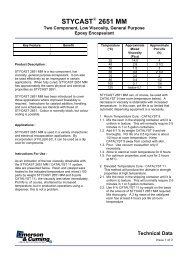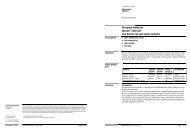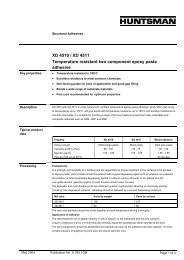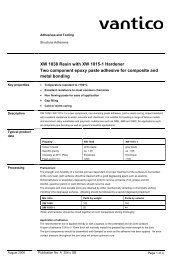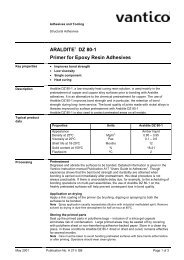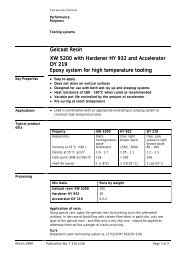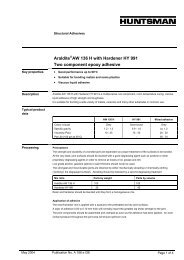Casting Resin XB 5912 100 Hardener XW 1235 18 Accelerator XW ...
Casting Resin XB 5912 100 Hardener XW 1235 18 Accelerator XW ...
Casting Resin XB 5912 100 Hardener XW 1235 18 Accelerator XW ...
You also want an ePaper? Increase the reach of your titles
YUMPU automatically turns print PDFs into web optimized ePapers that Google loves.
Vantico LtdElectronicPolymersHeavy Electrical® Araldite <strong>Casting</strong> <strong>Resin</strong> System<strong>Casting</strong> <strong>Resin</strong> <strong>XB</strong> <strong>5912</strong> <strong>100</strong><strong>Hardener</strong> <strong>XW</strong> <strong>1235</strong> <strong>18</strong><strong>Accelerator</strong> <strong>XW</strong> 528 0.3pbwpbwpbwGranulated prefilled, hot-curing, cycloaliphatic epoxy resin systemto produce castings with excellent mechanical end-properties .Outdoor electrical insulation for medium and high voltage applications,such as apparatus components, measuring transformers, bushings, etc.ApplicationsAutomatic pressure gelation process (APG)(see our special brochure, Publ. No. 28160/e)Conventional gravity casting process under vacuumProcessingVery good mechanical properties of the end-productNo sedimentation during storageEasy handling - good working conditionsEasy waste disposal of the packagingPropertiesEdition: July 2000Replaces Edition: December 1997
Product data(guideline values)<strong>Casting</strong> <strong>Resin</strong><strong>XB</strong> <strong>5912</strong>Granulated, formulated, cycloaliphatic epoxy resin, prefilled with silanized silica flourUncolouredEpoxy content ISO 3001 equiv/kg 1.2 - 1.3Density at 25°C ISO 1675 g/cm³ 2.3 - 2.4Apparent density at 60°C ISO 1675 g/cm³ 1.0 - 1.1Flash point DIN 51758 °C > 190<strong>Hardener</strong> <strong>XW</strong> <strong>1235</strong>Liquid, modified, cycloaliphatic anhydride hardenerViscosity at 25°C DIN 53015 mPa s 70 - 80Density at 25°C ISO 1675 g/cm³ 1.<strong>18</strong> - 1.20Anhydride content % > 98Flash point DIN 51758 °C 165Vapour pressure at 20°C (Knudsen) Pa 0.01at 60°C (Knudsen) Pa 0.1<strong>Accelerator</strong> <strong>XW</strong> 528Liquid, latent, amine/zinc complex acceleratorViscosity at 25°C DIN 53015 mPa s 1’400-2’<strong>100</strong>Density at 25°C ISO 1675 g/cm³ 1.1 - 1.2Flash point DIN 51758 °C 112Vapour pressure at 25°C (Knudsen) Pa < 0.2RemarksThe hardener <strong>XW</strong> <strong>1235</strong> is sensitive to humidity. It is necessary to store this product in thesealed original containers.StorageStore the components at <strong>18</strong>-25°C, in tightly sealed and dry, if possible, originalcontainers. Under these conditions, the shelf life will correspond to the expiry date statedon the label. After this date, the product may be processed only following reanalysis. Thestorage of the granulated <strong>XB</strong> <strong>5912</strong> at lower temperatures extends the shelf life.Partly emptied containers should be closed tightly immediately after use.For information on waste disposal and hazardous products of decomposition in the eventof fire, refer to the Material Safety Data Sheets (MSDS) for these particular products.2 Vantico Ltd. July 2000 <strong>XB</strong> <strong>5912</strong>/ <strong>XW</strong> <strong>1235</strong>/ <strong>XW</strong> 528Processing
(guideline values)General instructions for preparing prefilled liquid systemsLong pot life is desirable in the processing of any casting resin system. Mix all of thecomponents together very thoroughly at temperatures of 40°C and under vacuum. Propermixing will result in:- better flow properties and reduced tendency to shrinkage- lower internal stresses and therefore improved mechanical properties on object- improved partial discharge behaviour in high voltage applications.System preparationSpecific instructions for preparing granulated systemsThe hardener is filled in the mixer at 50-60°C.The granulated resin will be added, in the adequate portions, under continuous agitation.Once the resin is dissolved, the casting mix will be homogenized during around 30 minunder 0.5-5 mbar and then, the accelerator is added.Mixing time can vary from 30 to 90 minutes, depending on mixing temperature, mixingequipment and the particular application.The effective pot life is about 2 days at temperature < 25°C. Conventional batch mixersshould be cleaned once a week or at the end of work. For longer interruptions of work,the pipes of the mixing and metering installations have to be cooled and cleaned with theresin component to prevent sedimentation and/or undesired viscosity increase.Interruptions over a week-end (approx. 48h) without cleaning are possible if the pipes arecooled at temperatures below <strong>18</strong>°C.Viscosity increase and gel time at various temperatures, refer to Figs: 4.1 and 4.4.Specific InstructionsMould temperatureAPG process 130 - 160°CConventional vacuum casting 80 - <strong>100</strong>°CDemoulding times (depending on mould temperature and casting volume)APG process10 - 30 minConventional vacuum casting2 - 4 hCure conditions (minimal postcure)APG process 10h at 140°CConventional vacuum casting 6h at 140°CTo determine whether crosslinking has been carried to completion and the finalproperties are optimal, it is necessary to carry out relevant measurements on the actualobject or to measure the glass transition temperature. Different gelling and cure cycles inthe manufacturing process could lead to a different crosslinking and glass transitiontemperature respectively.Vantico Ltd. July 2000 <strong>XB</strong> <strong>5912</strong>/ <strong>XW</strong> <strong>1235</strong>/ <strong>XW</strong> 528 3
Processing(guideline values)Process Viscosities60000[mPa·s]50000400003000020000<strong>XW</strong><strong>1235</strong>: <strong>18</strong> pbw<strong>100</strong>00<strong>XW</strong><strong>1235</strong>: 20 pbw00 0.5 1 1.5 2 3 4 6 8 12 16 20 [h] 24Fig.4.1: Viscosity increase at 40°C (measurements with Rheomat 115)(Shear rate D = 10 s -1 )Gelation andCure Times<strong>100</strong>6040[min]20106421120 130 140 150 [°C] 160Fig.4.4: Geltime measured in function oftemperature(measurements with Gelnorm Instrument /DIN 16945/ 6.3.1)Exothermal Reaction(Heat Development according DIN 16945/ 6.2.1)<strong>XW</strong> <strong>1235</strong>: <strong>18</strong> pbw<strong>XW</strong> <strong>1235</strong>: 20 pbwMax. temperature(°C) 210 2134 Vantico Ltd July 2000 <strong>XB</strong> <strong>5912</strong>/ <strong>XW</strong> <strong>1235</strong>/ <strong>XW</strong> 528
Mechanical and Physical Properties(guideline values)Determined on standard specimen at 23°CCured for: 6h at 80°C + 10h at 140°CPart of <strong>XW</strong> <strong>1235</strong><strong>18</strong> pbw 20 pbwTensile strength ISO 527 MPa 90 - 105Elongation at break ISO 527 % 0.9 - 1.1E modulus from tensile test ISO 527 MPa 13’000 - 14’000Flexural strength ISO 178 MPa 150 - 160Surface strain ISO 178 % 1.3 - 1.4E modulus from flexural test ISO 178 MPa 13’000 - 13’500Compressive strength ISO 604 MPa 260 - 270Compression set ISO 604 % 12 - 13Impact strength ISO 179 kJ/m² 9 - 10Double Torsion Test CG 216-0/ 89Critical stress intensity factor (K IC ) MPa·m ½ 2.5 - 2.7Specific energy at break (G IC ) J/m² 450 - 50085 - 950.8 - 1.012’400 - 12’800Martens temperature DIN 53458 °C <strong>100</strong> - 105Heat distortion temperature ISO 75 °C 110 - 115Glass transition temperature (DSC) IEC <strong>100</strong>6 °C 105 - 115Coefficient of linear thermal expansion DIN 53752Mean value for temperature range: 20-60°C K -1 30 - 34·10 -6105 - 115Thermal conductivity similar to ISO 8894-1 W/mK 1.0 - 1.1Glow resistance DIN 53459 grade 2 bCombustibilty UL 94Thickness of specimen: 4 mm grade HBThickness of specimen: 12 mm grade V1Water absorbtion (specimen: 50x50x4 mm) ISO 6210 days at 23°C % by wt. 0.14 - 0.1660 min at <strong>100</strong>°C % by wt. 0.13 - 0.15Decomposition themperature (heating rate: 10K/min)DTA °C 350Density DIN 55990 g/cm³ 1.8 - 1.9Filler load pbw % 6968Vantico Ltd. July 2000 <strong>XB</strong> <strong>5912</strong>/ <strong>XW</strong> <strong>1235</strong>/ <strong>XW</strong> 528 5
Electrical PropertiesDetermined on standard specimen at 23°CCured for: 6h at 80°C + 10h at 140°C(guideline values)Breakdown strengthSpecimen with embedded Rogowski electrodesGap: 2mm Ciba method kV/mm 36 - 42Voltage test according IEC 243-1 kV/mm <strong>18</strong> - 25Diffusion breakdown strength DIN/ VDE 0441/1 class HD 2Temperature of specimen after test °C 23HV arc resistance ASTM D 495 s <strong>18</strong>8 - 193Tracking resistance IEC 112with test solution A CTI >600-0.0with test solution B CTI >600M-0.0Electrolytic corrosion DIN 53489 grade A1ε r161E<strong>18</strong>1412108tan δ [%][Ω cm]1E161E146421E121E<strong>100</strong>1E 810 50 90 130 [°C] 17010 50 90 130 [°C] 170Fig.6.1: Loss factor (tan δ) and dielectricconstant (εr) in function of temperature(measurement frequency: 50 Hz / IEC 250/ DIN 53483)Fig.6.2: Volume resistivity (ρ) in function oftemperature(measurement voltage: <strong>100</strong>0 V/ IEC 93/ DIN 53482)6 Vantico Ltd. July 2000 <strong>XB</strong> <strong>5912</strong>/ <strong>XW</strong> <strong>1235</strong>/ <strong>XW</strong> 528
Industrial hygieneMandatory and recommended industrial hygiene procedures should be followed wheneverour products are being handled and processed. For additional information pleaseconsult the corresponding Safety Data Sheets and the brochure "Hygienic precautions forhandling plastics products of Ciba Specialties Chemicals " (Publ. No. 24264/e).HandlingprecautionsSafety precautions at workplace:protective clothingglovesarm protectorsgoggels/safety glassesrespirator/dust maskSkin protectionbefore starting workafter washingCleansing of contaminated skinClean shop requirementsDisposal of spillageVentilation:of workshopof workplaceyesessentialrecommended when skin contact likelyyesrecommendedApply barrier cream to exposed skinApply barrier or nourishing creamDab off with absorbent paper, wash withwarm water and alkali-free soap, then dry withdisposable towels. Do not use solventsCover workbenches, etc. with light colouredpaper Use disposable breakers, etc.Soak up with sawdust or cotton waste anddeposit in plastic-lined binRenew air 3 to 5 times an hourExhaust fans. Operatives should avoid inhalingvapours.First AidContamination of the eyes by resin, hardener or casting mix should be treatedimmediately by flushing with clean, running water for 10 to 15 minutes. A doctor shouldthen be consulted.Material smeared or splashed on the skin should be dabbed off, and the contaminatedarea then washed and treated with a cleansing cream (see above). A doctor should beconsulted in the event of severe irritation or burns. Contaminated clothing should bechanged immediately.Anyone taken ill after inhaling vapours should be moved out of doors immediately. In allcases of doubt call for medical assistance.Vantico Ltd.Electronic Polymers®Registered trademarkAPPROVED TOISO 9000 ffAll recommendations for use of our products, wether given by us in writing, verbally, or tobe implied from results of tests carried out by us are based on the current status of ourknowledge. Notwithstanding any such recommendations the Buyer shall remain responsiblefor satisfying himself that the products as supplied by us are suitable for his intendedprocess or purpose. Since we cannot control the application, use or processing of theproducts, we cannot accept responsibility therefor. The Buyer shall ensure that the intendeduse of the products will not infringe any third party's intellectual property rights.We warrant that our products are free from defects in accordance with and subject to ourgeneral conditions of supply.25 July, 2000


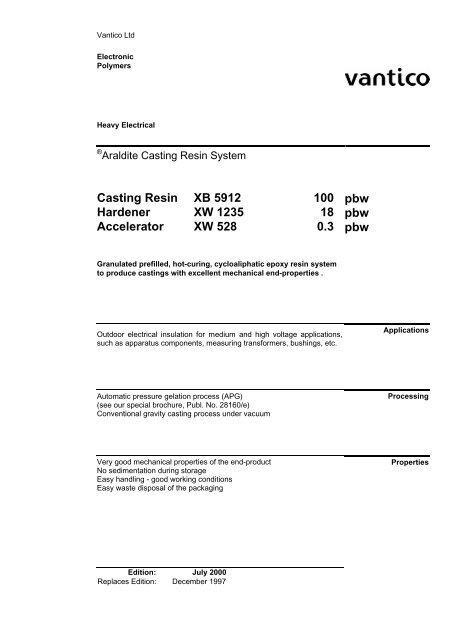
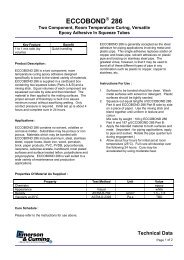
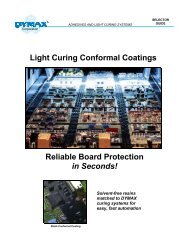

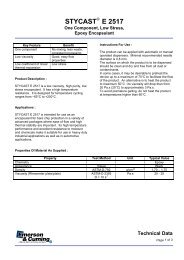
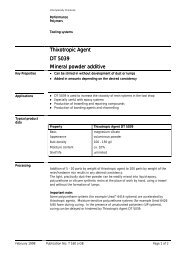
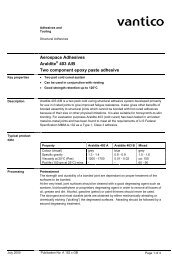
![[pdf] EXXON-TF56-TD - Lindberg & Lund AS](https://img.yumpu.com/52492677/1/190x245/pdf-exxon-tf56-td-lindberg-lund-as.jpg?quality=85)
